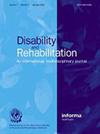Healthcare providers perspective of chronic pain management in persons with traumatic spinal cord injury accessing the public system in a region of South Africa.
IF 2.1
4区 医学
Q1 REHABILITATION
引用次数: 0
Abstract
PURPOSE Persons with traumatic spinal cord injury (PWTSCI) have expressed a lack of education from healthcare providers and poor shared-decision making between providers and clients. The aim was to explore the healthcare providers' perspective on factors influencing the optimal management of chronic pain. METHODS Healthcare providers were recruited from two institutions at tertiary healthcare level. Interviews explored current chronic pain management practices, influencing factors and recommendations for improvement. Data saturation occurred after interviewing 11 participants. Thematic analysis was used through a socio-ecological model. RESULTS The challenges to optimal pain management include appropriate assessment and management of psychological health (intrapersonal level), substance abuse amongst patients (intrapersonal level), access to medication for providers and lack of knowledge by providers (interpersonal and organizational level). To improve chronic pain management, an interdisciplinary team approach should be operationalized at policy and organizational level, monitoring and adjustment of interventions should take place (interpersonal), and family members/caregivers should be involved in the planning and monitoring (interpersonal). CONCLUSION Factors, at the interpersonal, intrapersonal, organizational and policy levels, influence optimal chronic pain management in the traumatic spinal cord injury (TSCI) population. To mitigate challenges, guidelines for chronic pain management should be developed, particularly for low-resourced developing countries.医疗服务提供者对南非某地区公共系统中外伤性脊髓损伤患者慢性疼痛管理的看法。
目的外伤性脊髓损伤患者(PWTSCI)表示缺乏来自医疗服务提供者的教育,而且医疗服务提供者与患者之间缺乏共同决策。该研究旨在探讨医疗服务提供者对影响慢性疼痛最佳管理的因素的看法。方法从两家三级医疗机构招募医疗服务提供者。访谈内容包括当前的慢性疼痛管理实践、影响因素和改进建议。在对 11 名参与者进行访谈后,数据达到饱和。结果最佳疼痛管理面临的挑战包括心理健康的适当评估和管理(人际层面)、患者滥用药物(人际层面)、医疗服务提供者获得药物的途径以及医疗服务提供者缺乏相关知识(人际和组织层面)。为改善慢性疼痛管理,应在政策和组织层面上实施跨学科团队方法,对干预措施进行监测和调整(人际层面),家庭成员/护理人员应参与规划和监测(人际层面)。为减轻挑战,应制定慢性疼痛管理指南,尤其是针对资源匮乏的发展中国家。
本文章由计算机程序翻译,如有差异,请以英文原文为准。
求助全文
约1分钟内获得全文
求助全文
来源期刊

Disability and Rehabilitation
医学-康复医学
CiteScore
5.00
自引率
9.10%
发文量
415
审稿时长
3-6 weeks
期刊介绍:
Disability and Rehabilitation along with Disability and Rehabilitation: Assistive Technology are international multidisciplinary journals which seek to encourage a better understanding of all aspects of disability and to promote rehabilitation science, practice and policy aspects of the rehabilitation process.
 求助内容:
求助内容: 应助结果提醒方式:
应助结果提醒方式:


